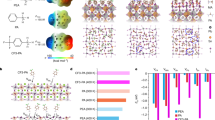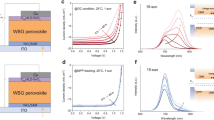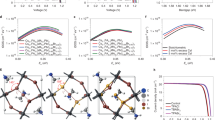Abstract
The broad bandgap tunability of organic–inorganic metal halide perovskites enables the fabrication of multi-junction all-perovskite tandem solar cells with ultra-high power conversion efficiencies (PCEs). Controllable crystallization plays a crucial role in the formation of high-quality perovskites. Here we report a universal close-space annealing strategy that increases grain size, enhances crystallinity and prolongs carrier lifetimes in low-bandgap (low-Eg) and wide-bandgap (wide-Eg) perovskite films. By placing the intermediate-phase perovskite films with their faces towards solvent-permeable covers during the annealing process, high-quality perovskite absorber layers are obtained with a slowed solvent releasing process, enabling fabrication of efficient single-junction perovskite solar cells (PVSCs) and all-perovskite tandem solar cells. As a result, the best PCEs of 21.51% and 18.58% for single-junction low-Eg and wide-Eg PVSCs are achieved and thus ensure the fabrication of 25.15% efficiency 4-terminal and 25.05% efficiency 2-terminal all-perovskite tandem solar cells.
This is a preview of subscription content, access via your institution
Access options
Access Nature and 54 other Nature Portfolio journals
Get Nature+, our best-value online-access subscription
$29.99 / 30 days
cancel any time
Subscribe to this journal
Receive 12 digital issues and online access to articles
$119.00 per year
only $9.92 per issue
Buy this article
- Purchase on Springer Link
- Instant access to full article PDF
Prices may be subject to local taxes which are calculated during checkout




Similar content being viewed by others
Data availability
The datasets analysed and generated during the current study are included in the paper and its Supplementary Information. Source data are provided with this paper.
References
Lin, R. et al. All-perovskite tandem solar cells with improved grain surface passivation. Nature 603, 73–78 (2022).
Zhao, D. & Ding, L. All-perovskite tandem structures shed light on thin-film photovoltaics. Sci. Bull. 65, 1144–1146 (2020).
Eperon, G. E. et al. Perovskite–perovskite tandem photovoltaics with optimized band gaps. Science 354, 861–865 (2016).
Zhao, D. et al. Four-terminal all-perovskite tandem solar cells achieving power conversion efficiencies exceeding 23%. ACS Energy Lett. 3, 305–306 (2018).
Tong, J. et al. Carrier lifetimes of >1 μs in Sn–Pb perovskites enable efficient all-perovskite tandem solar cells. Science 364, 475–479 (2019).
He, R. et al. Wide-bandgap organic–inorganic hybrid and all-inorganic perovskite solar cells and their application in all-perovskite tandem solar cells. Energy Environ. Sci. 14, 5723–5759 (2021).
Wang, C., Song, Z., Li, C., Zhao, D. & Yan, Y. Low-bandgap mixed tin–lead perovskites and their applications in all-perovskite tandem solar cells. Adv. Funct. Mater. 29, 1808801 (2019).
Wang, L. et al. A Eu3+-Eu2+ ion redox shuttle imparts operational durability to Pb–I perovskite solar cells. Science 363, 265–270 (2019).
Tan, H. et al. Efficient and stable solution-processed planar perovskite solar cells via contact passivation. Science 355, 722–726 (2017).
Zheng, X. et al. Defect passivation in hybrid perovskite solar cells using quaternary ammonium halide anions and cations. Nat. Energy 2, 17102 (2017).
Liu, Y., Dong, B., Hagfeldt, A., Luo, J. & Graetzel, M. Chemically tailored molecular surface modifiers for efficient and stable perovskite photovoltaics. SmartMat 2, 33–37 (2021).
Shi, T. et al. Effects of organic cations on the defect physics of tin halide perovskites. J. Mater. Chem. A 5, 15124–15129 (2017).
Wang, J. et al. Controlling the crystallization kinetics of lead-free tin halide perovskites for high performance green photovoltaics. Adv. Energy Mater. 11, 2102131 (2021).
Zhou, Y. et al. Manipulating crystallization of organolead mixed-halide thin films in antisolvent baths for wide-bandgap perovskite solar cells. ACS Appl. Mater. Interfaces 8, 2232–2237 (2016).
Bu, T. et al. Lead halide-templated crystallization of methylamine-free perovskite for efficient photovoltaic modules. Science 372, 1327–1332 (2021).
Li, N. et al. Liquid medium annealing for fabricating durable perovskite solar cells with improved reproducibility. Science 373, 561–567 (2021).
Xiao, K. et al. All-perovskite tandem solar cells with 24.2% certified efficiency and area over 1 cm2 using surface-anchoring zwitterionic antioxidant. Nat. Energy 5, 870–880 (2020).
Xiao, Z. et al. Solvent annealing of perovskite-induced crystal growth for photovoltaic-device efficiency enhancement. Adv. Mater. 26, 6503–6509 (2014).
Zhu, W. et al. Facile face-down annealing triggered remarkable texture development in CH3NH3PbI3 films for high-performance perovskite solar cells. ACS Appl. Mater. Interfaces 9, 6104–6113 (2017).
Liu, J. et al. Lead-free solar cells based on tin halide perovskite films with high coverage and improved aggregation. Angew. Chem. Int. Ed. 57, 13221–13225 (2018).
Zhu, L. et al. Solvent-molecule-mediated manipulation of crystalline grains for efficient planar binary lead and tin triiodide perovskite solar cells. Nanoscale 8, 7621–7630 (2016).
Chen, S. et al. Stabilizing perovskite-substrate interfaces for high-performance perovskite modules. Science 373, 902–907 (2021).
Jiang, X. et al. One-step synthesis of SnI2·(DMSO)x adducts for high-performance tin perovskite solar cells. J. Am. Chem. Soc. 143, 10970–10976 (2021).
Chen, S. et al. Crystallization in one-step solution deposition of perovskite films: upward or downward? Sci. Adv. 7, eabb2412 (2021).
Zhao, D. et al. Efficient two-terminal all-perovskite tandem solar cells enabled by high-quality low-bandgap absorber layers. Nat. Energy 3, 1093–1100 (2018).
Zhao, D. et al. Low-bandgap mixed tin–lead iodide perovskite absorbers with long carrier lifetimes for all-perovskite tandem solar cells. Nat. Energy 2, 17018 (2017).
Chen, Q. et al. Unveiling roles of tin fluoride additives in high-efficiency low-bandgap mixed tin–lead perovskite solar cells. Adv. Energy Mater. 11, 2101045 (2021).
Li, C. et al. Reducing saturation-current density to realize high-efficiency low-bandgap mixed tin–lead halide perovskite solar cells. Adv. Energy Mater. 9, 1803135 (2018).
Liao, W. et al. Fabrication of efficient low-bandgap perovskite solar cells by combining formamidinium tin iodide with methylammonium lead iodide. J. Am. Chem. Soc. 138, 12360–12363 (2016).
Yu, Y. et al. Synergistic effects of lead thiocyanate additive and solvent annealing on the performance of wide-bandgap perovskite solar cells. ACS Energy Lett. 2, 1177–1182 (2017).
Boccard, M. & Ballif, C. Influence of the subcell properties on the fill factor of two-terminal perovskite–silicon tandem solar cells. ACS Energy Lett. 5, 1077–1082 (2020).
Yang, M. et al. Facile fabrication of large-grain CH3NH3PbI3−xBrx films for high-efficiency solar cells via CH3NH3Br-selective Ostwald ripening. Nat. Commun. 7, 12305 (2016).
Zhang, G. et al. Synthesis of polymeric fluorescent brightener based on coumarin and its performances on paper as light stabilizer, fluorescent brightener and surface sizing agent. Appl. Surf. Sci. 367, 167–173 (2016).
Alsalloum, A. Y. et al. 22.8%-efficient single-crystal mixed-cation inverted perovskite solar cells with a near-optimal bandgap. Energy Environ. Sci. 14, 2263–2268 (2021).
Lu, H. et al. Vapor-assisted deposition of highly efficient, stable black-phase FAPbI3 perovskite solar cells. Science 370, eabb8985 (2020).
Li, D.-B. et al. Stable and efficient CdS/Sb2Se3 solar cells prepared by scalable close space sublimation. Nano Energy 49, 346–353 (2018).
Chen, Y. et al. Self-elimination of intrinsic defects improves the low-temperature performance of perovskite photovoltaics. Joule 4, 1961–1976 (2020).
Chen, C. et al. Optical properties of amorphous and polycrystalline Sb2Se3 thin films prepared by thermal evaporation. Appl. Phys. Lett. 107, 043905 (2015).
Lin, R. et al. Monolithic all-perovskite tandem solar cells with 24.8% efficiency exploiting comproportionation to suppress Sn(II) oxidation in precursor ink. Nat. Energy 4, 864–873 (2019).
Yu, Z. et al. Simplified interconnection structure based on C60/SnO2-x for all-perovskite tandem solar cells. Nat. Energy 5, 657–665 (2020).
Li, C. et al. Low-bandgap mixed tin–lead iodide perovskites with reduced methylammonium for simultaneous enhancement of solar cell efficiency and stability. Nat. Energy 5, 768–776 (2020).
Wang, C. et al. Compositional and morphological engineering of mixed cation perovskite films for highly efficient planar and flexible solar cells with reduced hysteresis. Nano Energy 35, 223–232 (2017).
Wang, C. et al. Low-temperature plasma-enhanced atomic layer deposition of tin oxide electron selective layers for highly efficient planar perovskite solar cells. J. Mater. Chem. A 4, 12080–12087 (2016).
Acknowledgements
The work was financially supported by the National Key Research and Development Program of China (number 2019YFE0120000), National Natural Science Foundation of China (numbers 61875143, 62005188, 62174112, and 62120106001), Natural Science Foundation of Jiangsu Province (BK20190825), Fundamental Research Funds for the Central Universities (numbers YJ2021157, 2021SCU12057, and YJ201955), the Science and Technology Program of Sichuan Province (numbers 2020JDJQ0030), Engineering Featured Team Fund of Sichuan University (2020SCUNG102) and Engineering Research Center of Digital Imaging and Display, Ministry of Education, Soochow University. F.F. acknowledges funding from the Swiss Federal Office of Energy (SFOE)-BFE (project number SI/501805-01).
Author information
Authors and Affiliations
Contributions
C.W. and D.Z. conceived the project. C.W. carried out single cell and tandem cell fabrication and characterization. Y.Z., Y.A. and R.H. helped with the fabrication of single-junction wide-Eg PVSCs in both regular and inverted structures. T.M. and J.Z. helped the device fabrication of single-junction low-Eg PVSCs. C.C. did the SEM, X-ray diffraction characterizations of single-junction PVSCs and helped the solvent annealing processes of both low-Eg and wide-Eg perovskite films. S.R. did the PL and TRPL measurements. C.W., F.F., D.Z. and X.L. analysed the data and wrote the manuscript. Y.Z., T.M., Y.A., R.H., J.Z., C.C., S.R. and F.F. helped with the manuscript preparation. All the authors discussed the results and commented on the manuscript. X.L. and D.Z. supervised the project.
Corresponding authors
Ethics declarations
Competing interests
The authors declare no competing interests.
Peer review
Peer review information
Nature Energy thanks Rohit Prasanna, Atsushi Wakamiya and the other, anonymous, reviewer(s) for their contribution to the peer review of this work.
Additional information
Publisher’s note Springer Nature remains neutral with regard to jurisdictional claims in published maps and institutional affiliations.
Supplementary information
Supplementary Information
Supplementary Figs. 1–31, Discussions 1–4, Tables 1–5 and References 1–4.
Supplementary Data 1
Supplementary Figs. 1 and 13h and Tables 1 and 3–5.
Source data
Source Data Fig. 2
Source data for Fig. 2c.
Rights and permissions
About this article
Cite this article
Wang, C., Zhao, Y., Ma, T. et al. A universal close-space annealing strategy towards high-quality perovskite absorbers enabling efficient all-perovskite tandem solar cells. Nat Energy 7, 744–753 (2022). https://doi.org/10.1038/s41560-022-01076-9
Received:
Accepted:
Published:
Issue Date:
DOI: https://doi.org/10.1038/s41560-022-01076-9
This article is cited by
-
Recent advances in Fe-N-C- and Co-N-C-based materials as bifunctional electrocatalysts for oxygen reduction and oxygen evolution
Science China Chemistry (2024)
-
Inorganic wide-bandgap perovskite subcells with dipole bridge for all-perovskite tandems
Nature Energy (2023)
-
Recent Advances in Wide-Bandgap Organic–Inorganic Halide Perovskite Solar Cells and Tandem Application
Nano-Micro Letters (2023)
-
Charge transport materials for monolithic perovskite-based tandem solar cells: A review
Science China Materials (2023)
-
A donor–acceptor-type hole-selective contact reducing non-radiative recombination losses in both subcells towards efficient all-perovskite tandems
Nature Energy (2023)



